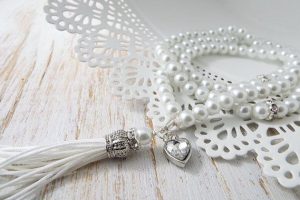
The Islamic Attire for Women
Islam is the perfect code of life. It provides complete guidance in all spheres of life and teaches man how to conduct and how to fulfill his worldly and deeni needs. Islam advocates respecting human rights and promotes sublime conduct when interacting with the creation. In aspects of honesty, trustworthiness, kindness to parents, respect to elders, and decency in manner, speech and dressing, Islam is second to none. From among the core values that Islam encourages one to adopt is the quality of Hayaa (shame and respect).
While hayaa is not confined to clothing and attire, hayaa in dressing and attire forms an essential and integral branch of Islam, as it is through a person’s clothing and attire that his Islamic identity is recognized. Through looking at the religious symbols on people, one automatically understands which religion they belong to. Hence, when a Mu’min adorns himself with the attire of Islam, he reflects the beauty of Islam and is identified as a believer.
Rasulullah (sallallahu ‘alaihi wasallam) had prophesized the coming of such crucial and critical times in the ummah where women will be clothed in transparent clothing or clothing revealing the shape of their bodies. Rasulullah (sallallahu ‘alaihi wasallam) had sounded severe warnings and admonitions for such women.
Hazrat Abu Hurairah (radhiyallahu ‘anhu) reports that Rasulullah (sallallahu ‘alaihi wasallam) said, “There will be two groups (in my ummah) who will be punished in Jahannum whom I have not yet seen (i.e. they will emerge after my demise). One group will carry whips with them resembling the tails of cattle, with which they will (oppressively) lash the people. The second group will be those women who will wear clothes yet will still be naked (i.e. they will wear tight fitting or clothing revealing the shape of their bodies), they will attract men towards themselves, and they themselves will be inclined towards men, their heads will resemble the humps of the Bukhti camels (i.e. they will wear buns which will be high like camel humps). They will neither enter Jannah nor smell its fragrance despite its fragrance being perceivable from a great distance away. (Saheeh Muslim #2128)
Rasulullah (sallallahu ‘alaihi wasallam) placed great emphasis upon this branch of Islam, and whenever he saw that the attire of the Sahaabah (radhiyallahu ‘anhum) was not conforming to Islam, he immediately corrected them.
On one occasion Hazrat Asmaa (radhiyallahu ‘anha), the respected sister of Hazrat Aaishah (radhiyallahu ‘anha), entered the home while wearing a thin garment. Rasulullah (sallallahu ‘alaihi wasallam) was displeased with this attire for the women of this ummah and immediately corrected her. He explained to her that the entire body of a woman should be covered in a manner that together with the cloth being non-transparent, even the shape of the body should not be discernible. (Sunan Abi Dawood #4106)
This lesson of hayaa, taught with respect by Rasulullah (sallallahu ‘alaihi wasallam), was so deeply entrenched in the heart of Hazrat Asmaa (radhiyallahu ‘anha) that it remained with her until the end of her life. Hence, it is reported that when she reached old age, her beloved son, Hazrat Munzir bin Zubair (radhiyallahu ‘anhu), after returning from Iraq, sent her a cloth as a gift. The cloth was of very fine and superior quality, however it was thin and revealing.
Hazrat Asmaa (radhiyallahu ‘anha) had lost her sight at that time, and so held the fabric in her hand, examining it carefully. Then, with disappointment, she said, “Return the gift to him.” When the cloth was returned to her son, Hazrat Munzir (radhiyallahu ‘anhu), he was hurt at his mother returning his gift. He came to Hazrat Asmaa (radhiyallahu ‘anha) and said to her, “O my mother, the cloth is not transparent! (Hence, it is fine for you to wear).” Hazrat Asmaa (radhiyallahu ‘anha) replied, “Even though it is not transparent, due to it being tight, it will still reveal the shape of the body.”
He thereafter bought for her common garments made in Marw and Quhistaan. She accepted them saying, “It is these types of garments that you should give me to wear (as these conform to the sunnah).” (Attabaqaatul Kubra li ibn Sad, pg. 199)
Shari‘ah has provided extensive guidelines in regard to the description of the clothing a woman should cover herself with.
- The clothing must provide cover for her entire body, otherwise in the eyes of Shari‘ah, the clothing will not be worthy of being called “clothing.” It is compulsory upon a woman to cover her entire body and hair (with the exception of her hands till her wrists and feet) before non-mahrams (strange men).
- The clothing must be such that it should neither be transparent nor reveal the shape of her body. Hence, if the clothing is tight-fitting to the extent that the shape of the body is discernable, such a woman is also included in the description of the Hadith being “clothed yet naked.”
- When leaving the home, a woman should ensure that the laws of hayaa and modesty are maintained. The Hadith commands that she should dress in an unattractive manner, should not apply perfume and she must don the niqaab. It is a fact of life that there exists a basic natural inclination towards the opposite gender. Wearing attractive clothing further incites such inclination which leads to fitnah.
- The type of clothing that is essentially worn by one gender should not be worn by the opposite gender. Rasulullah (sallallahu ‘alaihi wasallam) is reported to have said: “Allah Ta‘ala has cursed those men who imitate women (in dressing, etc.) and those women who imitate men.” (Tabraani #4003)
May Allah Ta‘ala revive the quality of hayaa among the women of this ummah and bless them with the tawfeeq of emulating the mubaarak sunnah of Rasulullah (sallallahu ‘alaihi wasallam) in their dressing and attire.
 Ihyaaud Deen An Effort to Revive Deen in Totality
Ihyaaud Deen An Effort to Revive Deen in Totality



